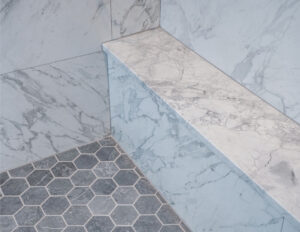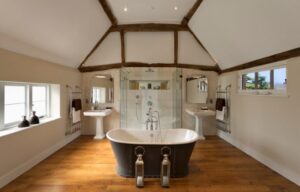Ever stood in a room and felt completely torn? On one hand, you’re dreaming of the clean lines and organic shapes of mid-century modern design. On the other, your heart yearns for the cozy, lived-in comfort of a farmhouse. You’re not alone. We talk to homeowners in Denver every single day who feel this exact same pull. They think they have to choose one style, and it’s a decision that can stall a whole home remodeling project.
Well, we’re here to let you in on a little secret: you don’t have to choose. Blending these two seemingly opposite styles isn’t just possible; it’s a recipe for a home that’s both strikingly cool and wonderfully welcoming. It’s all about finding the balance. So, let’s grab a coffee (or a craft beer, we don’t judge) and chat about how to create a space that’s uniquely you.
Contents
First, Let’s Get Our Definitions Straight
Before we start knocking down walls, we need to be on the same page about what we’re actually working with. IMO, the magic happens in the tension between these two aesthetics.
What Even Is Mid-Century Modern?
Think Mad Men, but maybe a little less whiskey-soaked and a little more family-friendly. Mid-century modern (or MCM, for those in the know) is all about:
- Form Follows Function: Every piece has a purpose. No fluff.
- Clean, Geometric Lines: Sharp angles, gentle curves, and a distinct lack of clutter.
- Organic Influences: Think teak wood, lush indoor plants, and lots of natural light.
- A Pop of Color: Mustard yellow, avocado green, and rusty orange were the stars of the show.
And On the Other Side, Farmhouse Style
Farmhouse style is the comfortable, reliable cousin. It’s less about impressing your friends and more about creating a space where everyone feels at home. Its key features include:
- Warm, Textured Materials: Shiplap walls, wide-plank wood floors, and lots of natural stone.
- Vintage and Handcrafted Elements: Anything that looks like it has a story to tell.
- A Softer Color Palette: Creamy whites, soft grays, and earthy tones rule here.
- Utilitarian Charm: Apron-front sinks, open shelving, and practical furniture.
See? They seem like total opposites. But their shared love of natural materials and honest craftsmanship is the secret handshake that lets them play nice together.
The Golden Rules for a Seamless Blend
Okay, now for the good stuff. How do we actually make this work without our living room looking like a thrift store explosion? We’ve guided countless clients through this in their custom remodels, and we’ve nailed down a few non-negotiable principles.
Anchor with a Neutral Foundation
You can’t go wrong by starting with a neutral base. This is your canvas. Think warm white walls, hardwood floors in a medium tone, or even polished concrete. This neutral backdrop allows you to layer in the more distinct personality pieces from both styles without the whole thing feeling chaotic. It’s the first thing we discuss with homeowners planning a whole house remodeling project.
Let Wood Be Your Best Friend
This is arguably the most important tip. Both styles adore wood, but they often use it differently.
- MCM loves teak, walnut, and rosewood—often with a sleek, oiled finish.
- Farmhouse prefers oak, pine, and reclaimed barn wood—usually with a more matte or distressed finish.
The trick? Don’t match the woods; coordinate them. Use the richer, sleeker MCM woods for statement furniture pieces (like a credenza or a dining table) and incorporate the more rustic, textured farmhouse woods for architectural elements like ceiling beams, floating shelves, or a feature wall.
Mix Your Lines and Textures
This is where the visual magic happens. A room with only clean lines can feel cold. A room with only rustic textures can feel like a theme park. The goal is to create balance.
- Place a sleek, low-profile MCM sofa against a wall of shiplap.
- Pair a rustic, live-edge wood coffee table with a iconic Eames lounge chair.
- Hang a minimalist geometric light fixture over a farmhouse table with chunky legs.
This contrast is what gives the blended style its depth and interest. It’s a technique we use all the time, especially in projects like a basement renovation or patio remodeling, where you’re often starting with a blank slate.
Room-by-Room: Putting Theory into Practice
Let’s get specific. How does this all come together in the actual rooms of your house? FYI, this is where hiring an experienced general contractor pays off—they can help you visualize these combinations before a single nail is hammered.
The Living Room: Your Style’s Home Base
Your living room is the perfect place to start this design experiment.
- Start with an MCM-style sofa: Look for one with clean lines and tapered wooden legs.
- Add a farmhouse-style rug: A jute, wool, or a vintage-style patterned rug adds instant warmth and texture underfoot.
- Mix your accent pieces: Use a sleek MCM side table on one side of the sofa and a rustic, wooden crate on the other.
- Lighting is key: Combine a modern arc floor lamp with a vintage-inspired ceramic table lamp.
The Kitchen: Where Function Meets Fashion
The kitchen is the heart of the home, and it’s a powerhouse for this style blend. This is a common focus for our luxury home renovations here in Denver.
- Cabinetry: Go for Shaker-style cabinets (a farmhouse staple) but in a rich, MCM-inspired walnut stain or a sleek, high-gloss white.
- Countertops: A leathered granite or quartzite offers a beautiful middle ground—it has the natural variation of stone with a texture that feels both modern and rustic.
- Fixtures and Hardware: This is your jewelry. Mix a farmhouse apron-front sink with a sleek, gooseneck kitchen faucet in matte black. Use minimalist bar pulls on the cabinets for an MCM touch.
- Furniture: An MCM dining set with upholstered chairs can sit perfectly in a kitchen nook with a shiplap wall.
The Bedroom & Bath: Your Personal Sanctuaries
For bedrooms and bathrooms, we want to lean into comfort without sacrificing style.
- Bedroom: A low-profile, platform bed (MCM) looks amazing when paired with a chunky, hand-knit blanket and a vintage quilt (farmhouse).
- Bathroom: A bathroom renovation contractor can help you install a walk-in shower with clean, subway tile (a nod to both styles) and contrast it with a vanity made from reclaimed wood. A statement, sculptural mirror brings the MCM element home.
Speaking of specific projects, this blended style works incredibly well in converted spaces. Thinking about a garage conversion? The existing concrete floor and structural beams are a perfect industrial-MCM base, which you can then soften immensely with farmhouse-style rugs, textiles, and furniture.
Your Go-To Style Mixing Cheat Sheet
Sometimes, you just need a quick reference. Here’s a handy table to guide your choices.
| Element | Mid-Century Modern Touch | Farmhouse Touch | The Perfect Blend |
|---|---|---|---|
| Seating | Eames Molded Plastic Chairs, Swan Chair | Slipcovered Armchair, Windsor Chair | A sleek MCM sofa with a chunky knit throw and linen pillows |
| Tables | Tulip Table, Noguchi Coffee Table | Trestle Table, Live-Edge Slab | A live-edge coffee table on a hairpin leg base |
| Storage | Teak Credenza, Wall-mounted Shelves | Pie Safe, Open Kitchen Shelving | A sleek media console placed under a rustic floating shelf |
| Lighting | Sputnik Chandelier, Arc Floor Lamp | Mason Jar Pendants, Wagon Wheel Chandelier | A geometric pendant light over a farmhouse dining table |
| Textiles | Bold Geometric Print, Sheepskin | Gingham, Burlap, Quilts | A neutral sofa with a mix of geometric and buffalo check pillows |
| Decor | Atomic Starburst Clock, Ceramic Vases | Galvanized Metal, Vintage Signs | A collection of vintage books next to a sleek, sculptural vase |
Pitfalls to Avoid (Or, How Not to Create a Hot Mess)
We’ve seen some things in our time as house remodelers. Let’s learn from others’ mistakes, shall we?
Don’t Go Overboard with Theming
Resist the urge to buy a “mid-century modern farmhouse” decor kit. This style is about curation, not a pre-packaged theme. Each piece should feel collected, not matched. A little sarcasm here: Your home shouldn’t look like a Pinterest board threw up in it.
Clutter is the Enemy
Farmhouse can sometimes veer into “clutter-core” with too many tiny knick-knacks. MCM despises clutter. The solution? Edit ruthlessly. Choose a few larger, meaningful statement pieces from each style instead of a hundred small ones. This is a common discussion point when we’re acting as your home addition contractor—more space doesn’t mean you have to fill every inch of it.
Ignore the Flow
You can’t just focus on one room. The blend should feel consistent as you move from your living room to your kitchen to your newly finished basement. A good remodeling company will help you think about the entire home’s flow, ensuring the style transition from room to room feels intentional and harmonious.
Okay, But Do I Need a Pro for This?
Honestly? It depends. You can probably handle painting a wall and styling a shelf yourself. But when it comes to the big stuff—like reconfiguring a layout, installing new floors, or tackling a basement remodel—having a professional home renovation contractor is a game-changer.
Why? Because they have the experience to see the whole picture. We can’t tell you how many times we’ve been called in to fix a basement renovation where the homeowner didn’t consider lighting placement or ceiling height, killing the vibe they were going for. A good contractor will:
- Help you avoid costly mistakes.
- Have a network of trusted basement contractors and bathroom renovation contractors.
- Source materials you might not have access to.
- Ensure the architectural changes support your design vision.
When you’re searching for a “home renovation contractor near me,” don’t just pick the nearest one. Look at their reviews, their portfolio, and make sure they get your vision. For our Denver readers, that’s where we come in. At Verified Builders, we live for this stuff. We love sitting down with clients and helping them navigate these exact design challenges.
Answers to Your Burning Questions
FAQ: Blending Mid-Century Modern and Farmhouse
1. Won’t my home just look messy and confused?
It might if you don’t follow a plan! The key is balance and a neutral foundation. You’re not decorating 50% MCM and 50% farmhouse. You’re creating a new, 100% cohesive style that borrows elements from both. We use a 70/30 rule as a starting point—let one style dominate (70%) and use the other as an accent (30%).
2. What’s the most important element to get right?
Scale and proportion. A huge, overstuffed farmhouse sectional will swallow a delicate MCM chair whole. Similarly, a massive rustic table will overwhelm a room full of sleek, low-slung furniture. Making sure the pieces feel like they belong in the same room, size-wise, is crucial. This is where a general contractor with a good eye can be invaluable.
3. Is this blended style a good choice for a whole house remodeling project?
Absolutely! In fact, it might be the perfect choice. Because it’s a balanced style, it tends to be very livable and appealing to a wide range of tastes. This is super helpful for resale value. You get a home that feels unique and personal but isn’t so aggressively themed that it turns off future buyers.
So, there you have it. Blending mid-century modern and farmhouse isn’t about following a strict rulebook; it’s about breaking a few to create a home that truly reflects you. It’s about that Eames chair next to your grandmother’s quilt. It’s warm, it’s cool, and it’s utterly unforgettable.
Ready to stop dreaming and start building? If you’re in Denver and this conversation has your mind racing with possibilities, give us a call at Verified Builders. Let’s create a home that’s so uniquely yours, your friends will be searching for their closest contractor to copy it :


